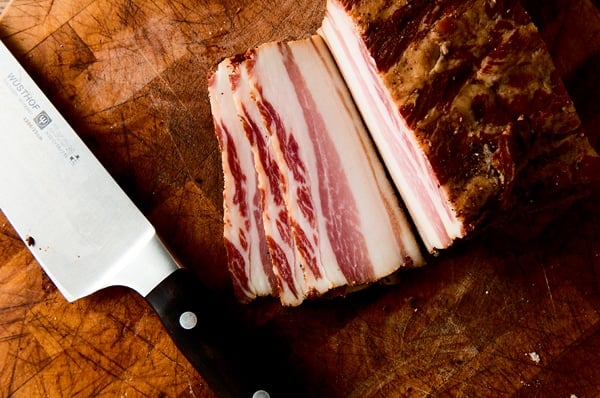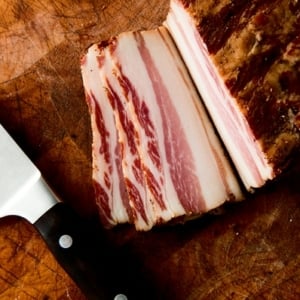As an Amazon Associate I earn from qualifying purchases.

German and Scandinavian food are not necessarily heavy, brown and boring. Tons of lighter, brighter dishes abound in those cuisines. But they do rely heavily on smoked meats, like bacon.
I looked around for an “authentic” German bacon recipe, but came up short. While I suspect that most bacon in Germany and thereabouts is simply cured with salt and smoked, I was looking for something with a little more regional character. And since I did not find one, I went about creating one.
I started with some pork belly. No reason this would not work with a fat wild boar, but it’d need to be a fat one. Then I tossed in a bunch of Germanic-Northern European flavors: German brandy, mustard, celery seed, caraway, garlic, marjoram and black pepper. Cured it 3 days in the fridge, turning it over each day, then off to the smoker.
Now I suppose you could smoke this over any wood you wanted, but to me, if it’s going to be German it needs to be smoked over beech, alder, birch or oak. I chose oak.
The result is perfect with German food. You mostly pick up the black pepper, celery seed, mustard and caraway, but you actually do get a hint of the brandy and the marjoram. The garlic is pretty subdued. I’ve sliced this and eaten it like regular bacon, but I mostly use it in stews and braises.
German bacon plays a starring role in my recipe for chanterelles and pumpkin spätzle; it is worth making this bacon solely for this dish. It ‘s so good it will make you want to don a dirndl or lederhosen and drink beer. Or maybe just drink beer…
German Bacon
Ingredients
- 3 pound slab of pork belly
- 2 tablespoons brandy, preferably German brandy
- 27 grams kosher salt, about 3 level tablespoons
- 4 grams curing salt (Instacure No. 1), about a heaping 1/4 teaspoon
- 1/4 cup brown sugar
- 1/2 teaspoon celery seed
- 1 teaspoon dried marjoram
- 1 teaspoon mustard powder
- 1 teaspoon caraway seeds, ground
- 2 teaspoons garlic powder
- 2 teaspoons black pepper
Instructions
- Find a container that will just about hold the pork belly, or use a heavy duty, sealable plastic bag. Massage the pork belly with the brandy over a bowl. If you have any extra brandy, pour it into the container or plastic bag.
- Mix all the dry ingredients for the cure together, then massage that into the meat. Put the pork and any remaining cure into the plastic bag or container, seal it and set it into the fridge for 3 to 5 days. Every 12 hours or thereabouts, turn over the pork. This helps distribute the cure evenly.
- Take the pork belly out and quickly rinse off the cure under cold water. Some cure will stick to the meat -- leave it, as it adds flavor. Pat the meat dry with paper towels and set on a cooling rack. Put the rack under a ceiling fan or in another cool, breezy place and let it dry for at least 2 hours, preferably 4. Or, you can put the meat on a cooling rack set in the refrigerator uncovered and leave it overnight.
- When you are ready to smoke, smoke the bacon at about 225°F for 4 to 6 hours. I never check internal temperature on the bacon, but if you are looking for a temperature, between 140°F and 165°F is fine. This is a pretty well-cured bacon so you don't need to cook the hell out of it. Allow to cool before using.
Notes
Nutrition
Nutrition information is automatically calculated, so should only be used as an approximation.





Hi do you take the rind of the pork
I just invested in a vacuum sealer. What about vacuum sealing for the curing stage? Better? Worse? No difference?
Ross: Better. It’s what I do nowadays.
Thanks!
Always looking for alternative spice blends for m bacon, and this one is great. However, I’ve heard beech has toxic properties for grilling and smoking…?
Can you use a pork shoulder instead of a belly?
Jim: Not for bacon. But I imagine you could cure a pork shoulder this way and then smoke it. It might take more than a week to cure in the fridge though.
I have done shoulders and they work great, they’re just not fatty bacon. Butterflying it so that the thickness is as consistent as possible is key. Nice, meaty, and ham-like!
We love this savory treat!!
Are you referring to Speck? If so, this recipe is not even close. I’ve never really heard of german bacon, and I grew up in Germany and lived there for 20 years.
Andreas: Nope, I am not, and I know this isn’t speck. It’s American bacon made with German-inspired flavors.
I’ve used this recipe 3 time now, always good. This time with my own goat whey raised Berkshires. Oh and in Tasmania, eucalyptus smoked. It’s a great recipie to mess with a little.
Moat of the other bacon recipes I find on the internet say cure the bacon for a week. I am concerned about the 3 day curing process. Can someone confirm that this recipe really only needs 3 days to cure? I’m trying to cure a bunch of bacon and only have 4 days to do it.
Bernie: Curing time reflects the thickness of the bacon. So some might take 3 days, some a week. If you only have 4 days, my guy says that’s not enough time unless you have a small piece of pork belly.
Hi,
Is the temperature 250°F (120C) right ?
I havent tried it yet, but suspect that fat will start to melt and drip in such temperature …
Ivar: Ah, yes. It is important to note that when I set my smoker at 250 degrees, it takes well over an hour to get there, and there is very little fat melt before it is done. You can certainly keep it down to 200 degrees Fahrenheit, though.
In this recipe for German Bacon, can I substitute Intacure 2 for instacure1?
Mike: No. They are different products entirely.
Thought I’d try this with a jowl that I have. Converted everything to metric since it was only .5 kg of jowl. Hopefully it’ll come out ok. Btw, 1 teaspoon of marjoram converted to grams is a lot of marjoram!
Where do you get your meet if you don’t hunt?
when you say alder do you mean box alder?
Robert: No. I mean alder. You are thinking of box elder.
Hank, I’m new to making bacon and can’t wait to try your German and Chinese bacon recipes. Is there any reason I couldn’t buy a belly, halve it, cure each half separately (one German, one Chinese)and smoke them together? I’ve love your site and can’t wait to get my copy of Buck, Buck, Moose. Keep up the wonderful work.
Beth: I don’t see any reason why not. And thanks for the kind words on Buck Buck Moose!
Hank,
I’m confused. How can you smoke the bacon for 4 to 6 hour at 250 and get an internal temp of between 140and 165? I smoke it at 200 and look for a temp of 150.that takes me am hour to an hour and a half.
Tim
Tim: My smoker takes a long time to heat up.
There is a lot of speculation out there and I am surprised that some of the Germans chiming in didn’t give you guys advice back then. “Curing” is something that has two meaning, so when Mr. T put it in the translator it came out as “healing”. That would make it difficult to find hits. Anyway, I grew up in the Frankonian part of Bavaria. We know VERY well what bacon is here, the further south you go, the more bacon is in the diet. My Dad used to say they have more bacon because of the energy they needed to do the hard work in the mountains (look up the pictures of “Südtiroler Bauernspeck”). Anyway, there are two ways to do Speck – air dry or smoke. Most of us cold smoke it just a little. Since I have just started with smoking I am not going to venture into detail about the techniques. The further south you go the more meat it has and the more air dried and less to no smoke. The skin is ALWAYS left on since it prevents drying out. Hope this is helpful to you all. Here is a link to what I consider Speck – bacon. It is known as “Durchwachsener Speck” which means literally “through grown bacon” which refers to the fat that marbles through the meat, it is cured and lightly smoked.
https://www.hofladen-portal.de/default/allergiker-sortiment/laktosefreie-produkte/durchwachsener-speck-vom-angler-sattelschwein.html
Just a quick addition to this thread. I saw this video today and thought of your recipe. The video is in German, but I think you can understand the steps. He is marinating in “Pökelsalz” (0.5% Nit.), black pepper, and juniper berry. After the meat is thouroughly preserved, it is soaked in fresh water, dried for two days, then cold smoked for a week for the Speck, longer for Schinken (which is like ham).
https://www.youtube.com/watch?v=thMrJCLqWCw
Andrew: Yep. I do, at least. But I also cook it like regular bacon.
Kristofor: I go by feel. Once it’s firm, I take it out of the cure.
The cure time on this is much shorter than I’m used to (seven days, with the same turning schedule), based mostly on the Charcuterie book by Ruhlman. Do you do this strictly by time or are you “monitoring” for doneness/firmness, etc? I have over-cured things using Ruhlman’s timeframe, but I’ve had them perfect as well. I’m sure it’s a factor of thickness of the cut, so I’m curious about your approach to timing. Thanks!
Hank, I’m used to uncooked American-style bacon, which must be cooked first. Does this come out of the smoker ready to eat?